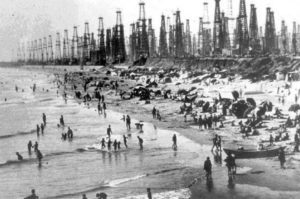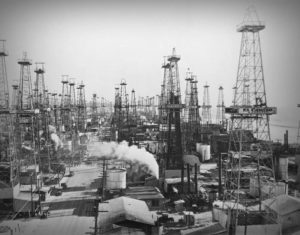The Los Angeles history of methane and oil drilling between the 1910s through the 1980s tragically endured many methane leaks and explosions. The ghastly aftermath from oil drilling causes methane leaks or carbon monoxide leaks. These two dangerous gases cause breathing difficulty, passing out, and death. Carbon monoxide forms through methane from organic matter in soil or surface water. Methane leaks are dangerous. As the growth of methane gas concentrates, then, when it meets a heat source, it will cause an explosion. This is like stove pilots creating home explosions. Methane is a highly flammable gas. This means that people would experience horrific health symptoms and deaths.
History of Methane and oil drilling
A quick history of the consequences of rapid methane and oil development is definable. Starting with Native Americans, who initially used oil as a sealant. For items for canoes or housing. The site of today’s La Brea Tar pits was once a place where Indians would gather this natural resource. Spaniards in the 1500s copied Native Americans and used oil as a sealant for their ships. Then in the 1800s, when the gold rush began, in Ojai there was an oil derrick in Sulphur Mountain by Thomas Bard and Josiah Stanford in 1866. It didn’t take off, however.

It wasn’t until 1892 when Doheny tapped into the Los Angeles Basin, where he built 80 wells. By 1897, there were over 500 wells. By the winter of 1922, the Long Beach Press advertised small tracts of land for sale in a community called “Petroleum Gardens,” Nicolaides said, with “all oil rights included.” This attracted people to move here. Also, what contributed were the secondary business sectors to support the expansion and demand for oil. The oil industry needed pumps, pipes, tanks, drilling rigs, and trucks.
Gassiest City in the world
Still, wells reside throughout in Huntington Beach, Long Beach, Santa Fe Springs, Dominguez, and Inglewood communities. While it’s positive to boom in population and wealth, the negative is not much was done to ensure safety standards. At the end of the 1920s, Los Angeles Times columnist Lee Shippey was bragging that “Los Angeles was the “gassiest” city in the world, far outpacing our cosmopolitan rivals in annual gas usage”. Hazards due to oil and methane were found through leaks and explosions rather than research.

So, public announcements regularly warned housewives suspicious of gas leaks to use soap water to test for seepage. The method here was, if the soap bubbles, use shellac or soap to cover the seam until a professional can fix the problem. Sadly, this method was not respected. Gas leaking from the sidewalk on Broadway downtown seeped into a large street clock. Unknowingly, a man struck a match on the base to light his cigarette, leading to an explosion. Smog got so bad that people would have watery eyes.
Leaks and Explosions

In the 1960s through the 1980s, more environmental problems came from oil and methane. Montebello had been built above hundreds of abandoned wells. Where a SoCal Gas Company storage facility resided and experienced decades of methane leaks. There was a horrible leak in 1985 at Mount Saint Mary’s College in West Los Angeles. A carbon monoxide leak from a faulty heater in Carondelet Hall poisoned dozens of students and several nuns. Those that were harmed suffered lingering symptoms, including nausea, memory problems, and lightheadedness.
They had to endure being in a pressure chamber to regulate their bodies after the leak. Lastly, in 1989, a leakage on third street caused fifty businesses to close temporarily. The result put in place requirements for buildings at risk must have venting systems, underground membranes, and methane gas detectors.
Sway Feature’s line of work is integral to maintaining and protecting current and future buildings from being susceptible to methane leaks. By conducting methane tests, installing membranes, and ventilation, these toxic gases will no longer harm people or the environment. With the history of so many oil wells, it is crucial to keep identifying leaks and prevent more health issues.
